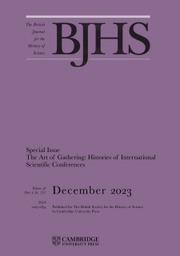With The Observatory Experiment, Simon Naylor continues his well-established work in both decentring spaces of sciences and showing how historical geographies are key to understanding particular practices and developments. Readers of Naylor’s previous work will not be surprised by the methodological approach that underpins the book. Drawing together many years’ detailed research on the topic, Naylor turns his attention to ‘the complicated and contested refashioning of meteorology as an experimental observatory science over the course of the nineteenth and early twentieth centuries’ (p. 4).
From Barbados to the top of Ben Nevis, Naylor draws the reader’s attention to a diverse range of observatory experiments in which different cultures of meteorology were contested. Following literature on astronomical observatories, Naylor first defines an observatory by its techniques as opposed to any ‘architectural expectation’ (p. 7). He then equates all meteorology observatory projects in the nineteenth century and the early twentieth with observatory experiments, extending the scope of the concept introduced by Fiona Williamson. Through a focus on these observatory experiments, Naylor brings to light negotiations that took place as actors tried to grapple with fluctuating expectations for both weather science as a discipline and the associated practices/spaces.
Chapter 1 takes us to sea and to a series of North Atlantic and Caribbean islands under British colonial rule that were crucial to commercial interests in the period studied. The chapter centres on meteorological cultures and the British Admiralty, particularly how ships came to be understood differently in the frameworks of Francis Beaufort, the Admiralty hydrographer between 1829 and 1855, and of William Reid, governor of the Bermuda islands between 1839 and 1846. Whereas both men agreed on the importance of meteorological observations taken in Admiralty spaces, they had different ideas both for the objectives of meteorology and for how navy ships should contribute to achieving these.
The difficulties in creating, trusting, moving and monitoring observations in what Naylor calls a British colonial observatory experiment are the focus of Chapter 2. The chapter begins by highlighting both the centrality and the challenges of data mobility in the physical sciences, largely by focusing on John Herschel’s writings. Naylor then details the early struggles of the Colaba Observatory in Bombay (now Mumbai) in living up to expectations of a model observatory. Later reforms that impacted this observatory reshaped networks of trust, instruments and observers as processes of computation and reduction were removed and centralized in Calcutta.
Chapter 3 explores the Ben Nevis Observatory from its establishment to eventual closure. After framing the work of the first volunteer observer, Clement Wragge, in the general context of mountaineering and high-altitude observations, the chapter follows questions of funding and functionality that haunted the observatory and its defenders across its existence.
Finally, Chapter 4 covers the efforts to understand Britain’s rain by a large and keen network of observers. One of Naylor’s self-stated aims for the book is to ‘develop a history of meteorology from the perspectives of its geographies’ (p. 5). This is definitely achieved by the overall volume, but the analytical pay-off from the finer focus taken to some issues in this final chapter (most obviously the rain gauge design) is a little unclear. Some sections seem focused on precisely the ‘disembodied debates’ (p. 4) that Naylor set out to avoid, and the chapter slightly suffers for this
Naylor concludes by identifying four key conditions in the lifespan of an observatory experiment: the significance of geographical particularity in justifying operations, the sustainability of coordinated yet distant observatory networks, the ability to manage and manipulate large data sets and the perceived value of the meteorology pursued. While the four conditions capture the broad outlines of the problems faced by all observatory experiments covered in the book, the strength of the titular concept shines most clearly in the third chapter. Naylor demonstrates the challenges that the Ben Nevis observatory directors faced with funding, the publication of data and the fluctuating identity of the observatory as a field site/laboratory. Disagreement over whether the observatory served (and was therefore the financial responsibility of) Scottish, British or European communities led to unresolvable conflicts over who should pick up the bill.
Chapter 3 was also useful for providing the reader with a more general sense of the changes to support for meteorological endeavours, helpful given the relatively long period covered in the book. By following the money, Naylor communicates a clear sense of how the status of meteorology was changing in metropole-based societies and institutions without ever having to explicitly centre these spaces.
Finally, while seemingly in keeping with Science in History editorial decisions, it would have been preferable for the rainfall maps in Chapter 4 to be printed in colour rather than accompanied by a textual description of shades. Happily, a coloured version of one of the rainfall maps appears in the October 2024 edition of the BSHS newsletter, Viewpoint. The extract provides a coherent overview of major themes that run through the book. Even though The Observatory Experiment is more expensive than the majority of books previously featured in this newsletter, if this extract intrigues readers, I would strongly recommend purchasing. The book is a model product of Naylor’s expertise and experience and clearly demonstrates how the spaces of observatory experiments shaped both developments and debates in the history of meteorology. More broadly, it exemplifies the benefit of applying the methods of historical geography to diversify the stories and spaces that feature in our narratives of the history of science.


